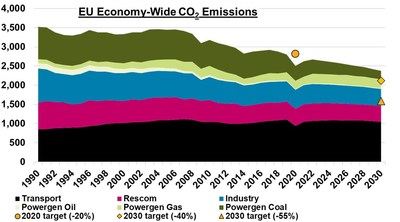S&P Global Platts Analytics: Huge Challenge to Move EU's Climate Target from Aspirational to Actual
S&P Global Platts has analyzed the EU's ambitious greenhouse gas reduction proposals aimed at a 55% decrease by 2030. The report notes that while the EU is taking significant steps, actual implementation remains a challenge. The EU's Carbon Border Adjustment Mechanism may not effectively reduce emissions in the near term. Platts projects that even if all power sector emissions were eliminated, it wouldn't suffice to meet the targets. Current EU emissions are expected to exceed 2030 goals, indicating that substantial measures are required for success.
- Platts recognizes the EU's proactive approach in setting ambitious climate targets.
- The Fit for 55 package initiates a foundational framework for addressing greenhouse gas emissions.
- Current EU emissions projections indicate they will exceed 2030 targets.
- The Carbon Border Adjustment Mechanism is unlikely to influence emissions reduction immediately.
- Achieving the proposed 55% reduction is complicated by existing capital and fleet constraints.
LONDON, July 14, 2021 /PRNewswire/ -- S&P Global Platts ("Platts"), the leading independent provider of information, analytics, and benchmark prices for the commodities and energy markets today issued analysis of EU's package of proposals for reducing greenhouse gas emissions by
The S&P Global Platts Analytics analysis notes that while the European Union is leading the way in setting ambitious targets and trying to develop and implement a real plan of action to achieve them, global nations will need to be more ambitious ahead and it will be particularly challenging to translate ambitious announcements to actuality.
Further, it concludes that with its narrow focus and contentious nature, an EU Carbon Border Adjustment Mechanism (CBAM) is unlikely to have any impact on carbon emissions in the near term.
Roman Kramarchuk, Head of Future Energy Analytics, S&P Global Platts: "The Fit for 55 package is a great start to achieving the EU's ambitious goals, but the reality is that this is far from a done deal. Final decisions are well down the road and full implementation will be several years away. Previous efforts from the EU (notably in aviation) have been tempered by the reality of seeking consensus, and there are plenty of reasons to believe we will see this package moderated over time. As for emissions in sectors like transportation and residential/commercial building, the main barrier will be the fact that capital stock and fleets cannot be changed on a dime – making 2030 targets a very tough reach. That said, our reference forecasts show EU emissions far over-shooting the
Analysis Highlights:
- While EU emissions are declining, Platts Analytics' most likely trajectory shows 2030 emissions remaining above current 2030 targets, and well above an aggressive
55% reduction target vs. 1990 levels. - As per our analysis – even if all power sector emissions were to go to zero, that would only represent a portion of what is needed to reach goal.
- The Fit for 55 package includes the Carbon Border Adjustment Mechanism that seeks to apply penalties to aluminum, steel, cement, fertilizer and electricity imported into the bloc to account for higher greenhouse gas emissions compared to domestic product.
- Platts has been assessing 'low carbon' aluminum duty-paid at Rotterdam since April this year. Thus far, buyers have not been willing to pay a premium over conventional aluminum for lower emissions material. We expect that to change if the CBAM moves into effect – low carbon aluminum is as much as 8 metric tons of CO2 equivalent (mtC02e) lower per ton of aluminum compared to the global average. At the current prices of EU emissions allowances that would represent a Eur400 per metric ton (/mt) of aluminum premium, compared with a current price of Eur2,366/mt for duty-paid aluminum at Rotterdam. In contrast, Platts has observed premiums being paid for carbon-offset commodities, notably in Asia, where buyers have been voluntarily paying about 7 cents/MMBtu to offset 'well-to-tank' GHG emissions.
Alan Hayes, Head of Energy Transition Pricing, S&P Global Platts: "CBAM lays the groundwork for a new framework for full supply-chain analysis and valuation of greenhouse gas emissions. Commodity markets have started to embrace the 'carbon accounting' approach and this is growing significantly across a range of sectors. However, there are important questions about how supply chains are analyzed and what verifications and validations are applied to individual cargoes and shipments."
Copenhagen Accord
- -
20% vs. 1990 levels by 2020 (yellow circle on chart)
Paris Agreement (NDC)
- -
40% vs. 1990 levels by 2030 (yellow diamond on chart)
Proposed EU Climate Law
- -
55% vs. 1990 levels by 2030 (yellow triangle on chart) - Net-zero GHG by 2050
- "Fit for 55" package, >11 legislative initiatives to implement targets
Visit Platts Live for more on carbon-neutral LNG and energy transition updates.
About S&P Global Platts
At S&P Global Platts, we provide the insights; you make better informed trading and business decisions with confidence. We're the leading independent provider of information and benchmark prices for the commodities and energy markets. Customers in over 150 countries look to our expertise in news, pricing and analytics to deliver greater transparency and efficiency to markets. S&P Global Platts coverage includes oil, gas, LNG, power, petrochemicals, metals, agriculture and shipping.
S&P Global Platts is a division of S&P Global (NYSE: SPGI), which provides essential intelligence for individuals, companies and governments to make decisions with confidence. For more information, visit www.platts.com.
![]() View original content to download multimedia:https://www.prnewswire.com/news-releases/sp-global-platts-analytics-huge-challenge-to-move-eus-climate-target-from-aspirational-to-actual-301334014.html
View original content to download multimedia:https://www.prnewswire.com/news-releases/sp-global-platts-analytics-huge-challenge-to-move-eus-climate-target-from-aspirational-to-actual-301334014.html
SOURCE S&P Global Platts









